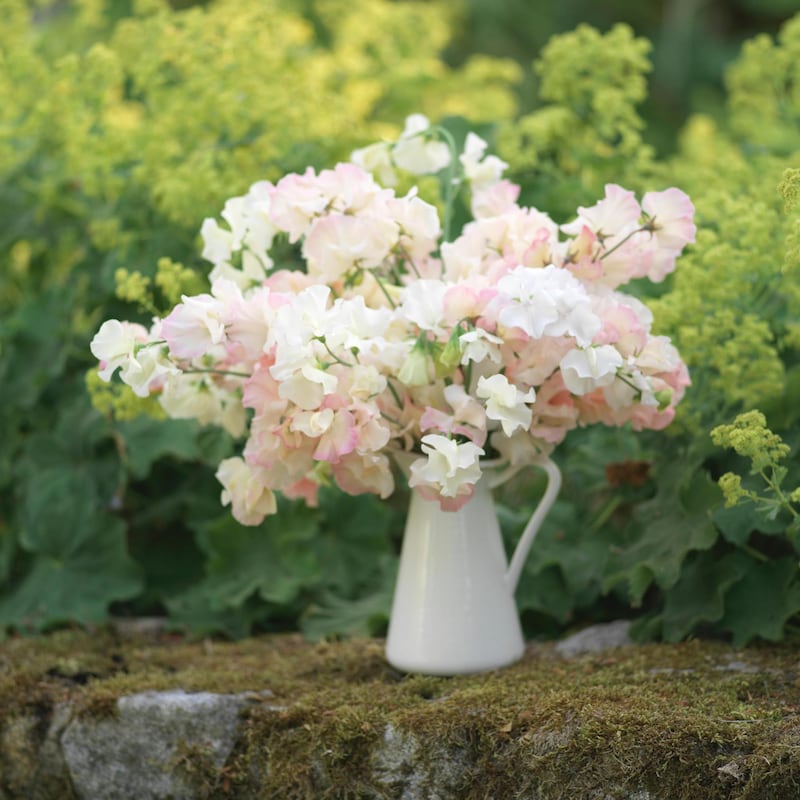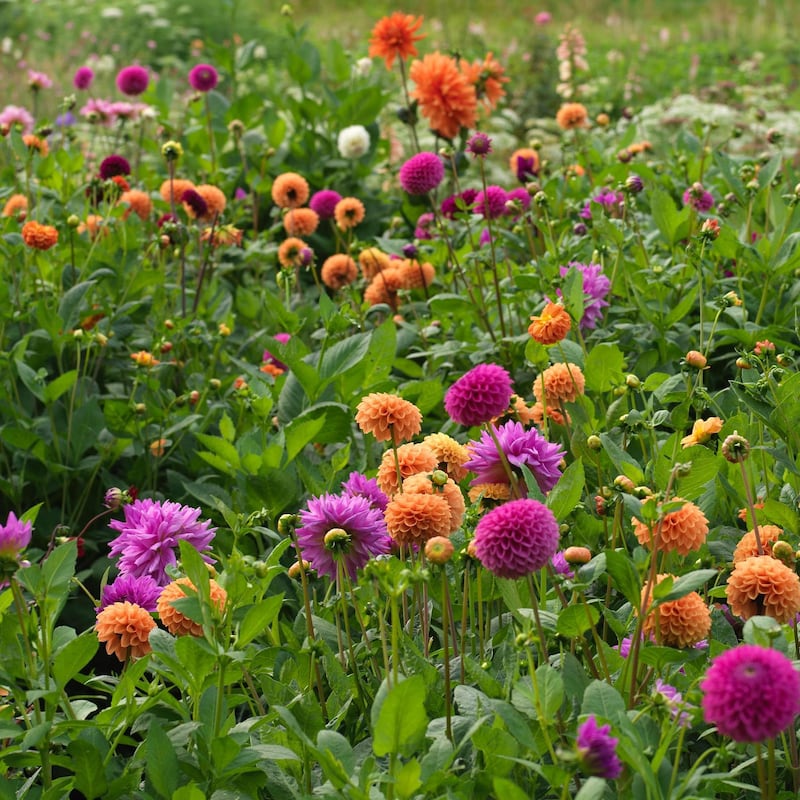Hauntingly beautiful, intensely perfumed, floriferous, colourful and surprisingly easy to grow, sweet pea has few rivals among flowering plants for my affections. No summer garden is truly complete without the ruffled, ephemeral beauty of its delicate flowers or that endorphin-inducing evocative scent, a perfume that impels you to bury your face in its fragile blooms and inhale slowly and deeply. It’s no wonder this hugely decorative member of the pea family is so fondly known to many gardeners as the queen of the annuals.
An annual plant, as you may already know, is one that lives no more than a year and sometimes a lot less depending on the particular species’ ability to withstand winter cold. Some – the more short-lived types known as half-hardy annuals – can only be sown in spring under cover and with gentle heat, or outdoors once the soil has warmed up.
Instagram is littered with proud photos of pathetically invalidish sweet-pea seedlings that are the unfortunate results of helicopter gardening
The fragile, fleeting beauty of its flowers belies the fact that sweet pea is actually what’s known as a hardy annual, meaning it will tolerate a surprising degree of frost (as low as minus 5 degrees) and thus it does very well from an autumn sowing. Sow it between now and the end of November and you will get bigger, stronger, earlier-flowering, longer-flowering, better performing, more resilient plants (plus longer flower stems) than from seed sown in late winter or mid-spring.
How to sow it? The first thing is to make sure you’re using good-quality seed that’s as fresh as possible (see below for specialist suppliers). Some gardeners believe that ‘chipping’ each seed by using a sharp knife to remove a tiny portion of its hard, outer skin helps germination. I don’t do this, but I do pre-soak it overnight in a bowl of water (a technique that also divides sweet-pea growers) before ‘chitting’ or pre-sprouting the seeds by putting them inside a small lidded container or jam jar, its base lined with damp kitchen paper.
Signs of growth
Placed indoors in a spot that’s warm but not broiling (10 to 15 degrees), you should see signs of growth within a week as each seed begins to throw out its tiny white root radicle followed by a baby green shoot. Once you spot these all-important signs of life, it’s time to very quickly – but oh so very gently – sow each seed into its own small, deep pot or root-trainer filled with a good quality multi-purpose compost. Just make sure to avoid damaging the new growth while doing so and to sow to a depth of no more than ½in/12mm deep before watering gently with a watering can.
The next step, the one at which so many novice gardeners falter, is to resist the temptation to mollycoddle your sweet-pea-plants-in-the-making by placing those freshly-sown pots/ root-trainers on a warm, sunny windowsill indoors where they will inevitably produce weak, wan, leggy plants (Instagram is littered with countless proud photos of pathetically invalidish sweet pea seedlings that are the unfortunate results of this sort of helicopter gardening).
Instead, you need to take the Spartan approach by growing them ‘hard’ and quickly accustoming them to cooler temperatures. So immediately after sowing, place the pots/ root-trainers somewhere cool and bright. This could be in a bright, unheated glasshouse or cold frame (but make sure to keep these very well-ventilated on sunny days) or simply in a bright, relatively sheltered spot outdoors under the protective overhang of a roof or close to a house wall. You should see signs of the emerging seedlings within one-two weeks.
You’ll need to take precautions against mice and birds (they love to steal the seed) by covering the pots/ root trainers with a fine-mesh netting suspended above them (so that the emerging seedlings don’t get snagged in it) and tucked in beneath them. It’s also important to take precautions against slugs, for which reason I put my pots on an old trestle table, with each of its four legs in a bucket of water.
Don’t be worried by the fact that initial growth will seem terribly slow. There’s a lot going on below the surface as each seedling begins the important process of establishing a healthy, well-developed root system.

Above ground
Once your seedlings appear above ground, keep the compost slightly moist but not sodden, especially during the early weeks of growth. To produce fat, bushy, floriferous plants and encourage side-shoot formation, many growers recommend the growing tip of each young seedling is nipped out above the first two-three sets of true leaves. But if you’re growing your autumn-sown sweet pea plants as ‘hard’ as you should be, then they’ll often naturally produce these side-shoots themselves without any need to nip them out. So only give them temporary extra protection in the form of garden fleece when the temperature is forecast to sink below minus 5 degrees. The result will be strong, vigorous plants with well-developed root systems that you can plant out into their final growing positions by late March/ early April.
Make sure to give your sweet pea plants a sunny spot in a weed-free and very fertile, moisture-retentive soil enriched with plenty of organic matter and a generous sprinkle of pelleted organic fertiliser. Keep them very well-watered (they hate their roots to dry out) and offer some sort of tall, sturdy support capable of taking the weight and size of the adult plants, which can easily reach a height of 6-8ft/ more than 2m, in the right growing conditions. You’ll also need to tie in young growth.
After that, it’s a simple case of picking armfuls of those delightful and deliciously scented bloom every couple of days to encourage the production of fresh flowers. Which is not what you’d call a terrible hardship.
Five great sweet pea varieties to grow from seed: 'Earl Grey', a bi-coloured, flaked variety with maroon/purple/white wavy flowers; 'Just Jenny', a strong, vigorous, violet-flowered variety with nice long stems; 'Jilly', large, sweetly-scented ivory-cream flowers; 'Oban Bay', silver-blue, strongly scented flowers; 'Mollie Rilstone', creamy-pink picotee flowers perfect for wedding bouquets. Recommended specialist suppliers of sweet pea seed: englishsweetpeaseed.co.uk; rpsweetpeas.com; sweetpeasonline.co.uk; somersetsweetpeas.com
THIS WEEK IN THE GARDEN
When autumn frosts have blackened the flowers and soft, lush growth of frost-tender plants such as dahlias, tuberous begonias, gladioli and cannas, it’s the signal to cut away the foliage and faded flowers before using a garden fork or spade to gently lift their tubers/corms/rhizomes. Then wash off the remaining soil and let them dry off before placing them in trays/ boxes of dry compost to store somewhere cool, dark and frost-free for the winter months. In milder parts of the country, gardeners often get away with leaving these tender plants outdoors over winter by protecting them with a thick mulch of dry leaves, straw, spent compost or well-rotted manure – but as last winter’s extended cold spell proved, this is a gamble .
Mid-October is often a tricky time for polytunnel-grown and glasshouse-grown plants – with a combination of wet, windy weather, decreasing growth levels and plunging night-time temperatures making it difficult to strike the right balance in terms of adequate ventilation and watering.
As a result, common plant diseases including mildew and grey moulds often set in at this time of year. But you can do a great deal to help keep plants healthy by regularly removing and bagging any decaying or diseased foliage, faded flowers and finished crops, only watering in the morning, and leaving vents and doors open on any milder days (as long as there aren’t strong winds forecast) while making sure to close them up again in the evening.

If you have lots of growing space going a-begging in your polytunnel or glasshouse, then there’s still time to sow oriental salad leaves and hardy winter lettuce varieties, chard, mangetout peas, kohl rabi and early carrots and to plant Florence fennel and spring cabbage. Spring-flowering bulbs planted into crates can also be overwintered in the polytunnel or glasshouse for extra early blooms for the house.
If you haven’t already done so, then lift half-hardy perennials and sub-shrubs such as bedding fuchsias, argyranthemums, half-hardy varieties of salvia and pelargoniums and move them indoors (the windowsill of an unheated room, a porch or cool conservatory are all suitable) or under cover of an unheated glasshouse to protect them from frost damage. Water only just enough to keep the compost the tiniest bit damp rather than sodden. If you’re overwintering plants in an unheated glasshouse, a layer of garden fleece will give extra protection during very cold spells.
DATES FOR YOUR DIARY
Thursday, October 18th (7.30pm), The Ship Room, Edmund Rice Centre, Barrack Street, Waterford, 'Gardener's Question Time', an RHSI Regional Event in association with Waterford Regional Gardening Club (WRGC) with a distinguished panel of garden experts including Hester Forde (of Coosheen Garden), Geoff Stebbings (garden writer and editor) and Mary Keenan (of Gash Gardens and nursery). Members of RHSI and WRGC €10, non-members €15, booking with payment essential. Call RHSI Office, 01-493 7154, or WRGC Committee, 086-408 3419 or 087-650 2067.
Thursday, October 18th (8pm-10pm), St Brigid's Parish Centre, St Brigid's Church Road, Stillorgan, Dublin, 'Thirty-five years and still growing', a talk by Ian Christie on behalf of Alpine Garden Society Dublin Group, see alpinegardensociety.ie
Tuesday, October 23rd (8pm), Foxrock Parish Pastoral Centre, Kill Lane, Dublin 18, 'Hellebores & Friends', a lecture by Dr Julian Sutton of UK-based specialist nursery 'Desirable Plants' on behalf of Foxrock & District Garden Club, see foxrockgardenclub.com












